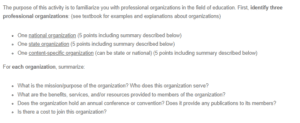Professional Organizations-Knowledge is Power Program
The three professional organizations identified are the National Education Association (NEA), The Knowledge is Power Program (KIPP), and the American Federation of Teachers AFT. The National Education Association (NEA) is a national organization that began in 1857 and quickly attracted members because of the inequities involving teachers’ pay and other forms of compensation (Kauchak & Eggen, 2015). It is the largest professional teacher entity that serves teachers and students. The primary purpose is collective bargaining on the teacher’s behalf. The organization’s mission is “No matter your passion, position, or location, NEA will help you,” meaning NEA has several teacher benefits (InTASC Standards, 2013). These benefits include having a voice at the table because they offer collective bargaining on teachers’ behalf. The members can earn increased benefits and pay, including health care, retirement security, and professional pay. It also helps teacher grow their professional practice by working with the school district to establish mentoring and other support from more qualified colleagues. Indeed NEA holds annual conferences each summer to debate vital issues concerning public education, and it also gives publications to its members. Unfortunately, there are costs to joining the organization. Do you need any help for completing your assignment ? Contact us at eminencepapers.com. We endeavor to provide you with excellent service.
The selected state organization is the Knowledge is Power Program (KIPP), which began in 1994. It is one of the most popular and effective charter school organizations. The purpose of KIPP is to emphasize high expectations for all learners, parent and student commitment, empowered leaders with suppleness in personnel and budgeting, and regular learner assessments that inform constant improvement. The organization serves parents, students, and the state. It also consists of a national network of free, open enrolment charter schools that often targets grades 5-8. It also has several benefits for learners, parents and teachers. They build KIPP schools across Districts. For instance, in 2013, more than 100 KIPP schools were operating in 20 states, and Columbia District served more than 30,000 learners (Kauchak & Eggen, 2015).
Other benefits are it achieves the expectations of low-income families because most KIPP learners originate from Hispanic or Black families living under the poverty line. They effectively achieve a low attrition index and heighten positive indicators among learners. In addition, KIPP helps yield better student results in reading, English language, and mathematics in middle and high school. It also positively impacts social studies and science achievement among learners. KIPP, through their schools, also prepares learners for college life and life after school. This they try to achieve by transforming the culture of the school with a “no excuses” approach to learning a “no nonsense” philosophy of class management (Kauchak & Eggen, 2015). KIPP ensures hard work is appreciated through trips. It also provides tools and resources to learners and teachers. For instance, teachers are offered training for excellent instruction. Lastly, the organization holds annual conferences, and they also provides publications to its members, there are costs for joining the organization.
The final content-specific organization is the American Federation of Teachers (AFT). This is the second leading teacher professional union after NEA. It participates in numerous preliminary teacher assessment schemes underscoring school or group-level motivations instead of individual tutor-based strategies. AFT’s mission is to champion equality, impartiality, first-class public instruction, public facilities for learners, people, communities, and economic opportunity. This organization serves teachers, parents, and students. Its benefits include working for better benefits and higher pay and fighting for better working environments for its associates. The organization additionally provides various services and benefits to its members, such as retirement saving plans, low-cost insurance, legal representation, consumer discounts, and credit union services (Kauchak & Eggen, 2015). Finally, the entity conducts annual meetings. It provides periodical publications to its affiliates through weekly e-mails and newsletters. Sure, there are costs for joining the organizations.
References
InTASC Standards (2013). InTASC Standard 9: Professional Learning and Ethical Practice Model Core Teaching Standards and Learning Progressions for Teachers
Kauchak, D., & Eggen, P. (2015). Introduction to teaching: Becoming a professional. Pearson.
ORDER A PLAGIARISM-FREE PAPER HERE
We’ll write everything from scratch
Question
The purpose of this activity is to familiarize you with professional organizations in the field of education. First, identify three professional organizations: (see textbook for examples and explanations about organizations)

Professional Organizations-Knowledge is Power Program
- One national organization (5 points including summary described below)
- One state organization (5 points including summary described below)
- One content-specific organization (can be state or national) (5 points including summary described below)
For each organization, summarize:
- What is the mission/purpose of the organization? Who does this organization serve?
- What are the benefits, services, and/or resources provided to members of the organization?
- Does the organization hold an annual conference or convention? Does it provide any publications to its members?
- Is there a cost to join this organization?

